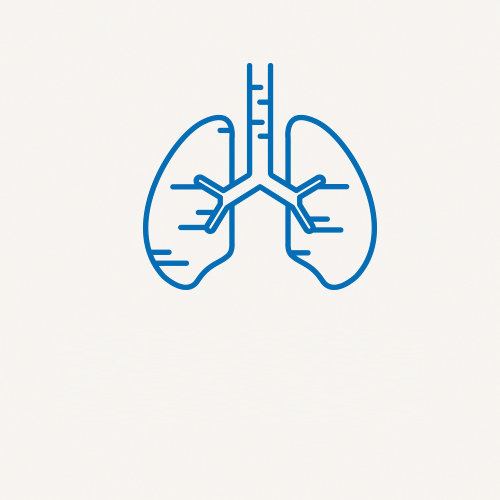Frequently asked questions about tuberculosis. (FAQs)
General Questions
What is tuberculosis?
Tuberculosis is an infectious disease and is caused by a slowly growing bacteria called Mycobacteria tuberculosis. The bacteria can be transmitted from person to person by coughing, sneezing, singing or speaking. It is estimated that after an infection, only about 5–10% of people become ill. It can take months – sometimes even years – between infection and illness. A sick person usually develops symptoms some time after infection. Typical symptoms include coughing, mild fever, or weight loss. If these symptoms persist for a long time, it may be tuberculosis. If tuberculosis bacteria are detected, the effectiveness of the tuberculosis medications is tested in the laboratory. In Germany, all four standard medications (isoniazid, rifampicin, pyrazinamide, ethambutol) are effective in about 90% of the tested cases and can therefore be used. Patients must take the standard medication for at least six months and get cured in most cases.
However, only about one in ten people develop a disease after an infection. In 2018, 10 million people contracted tuberculosis, and about 1.5 million people died. Tuberculosis is therefore still one of the 10 most frequent causes of death worldwide.
last update February 2020
How can I tell if I have tuberculosis? What are the typical symptoms?
People who suffer from pulmonary tuberculosis often have a cough and a mild fever. However, these symptoms are not specific and also occur with common colds, for example. However, if the symptoms persist for several weeks or if other symptoms such as heavy sweating, unwanted weight loss, or fatigue appear, tuberculosis must also be considered. It is then necessary to have a chest x-ray and possibly further examinations. In rare cases, tuberculosis can also affect organs other than the lungs. Especially if you had contact with someone with tuberculosis, you should consult a doctor if you have any of the symptoms.
last update February 2020
How do you get tuberculosis?
If someone has pulmonary tuberculosis and the focus of inflammation is connected to the respiratory tract, tiny droplets containing bacteria can be released into the air by coughing, singing, sneezing or speaking. In case these are inhaled by another person, infection may occur. There is only a risk of infection if the sick person coughs up bacteria with the sputum. This is not the case with every patient with pulmonary tuberculosis. If tuberculosis affects an organ other than the lung (so called extrapulmonary tuberculosis), there is usually no risk of infection. If contagious tuberculosis is treated, the patient is often no longer contagious after just a few weeks of effective therapy.
last update February 2020
Is tuberculosis life-threatening?
Tuberculosis is almost always curable when treated effectively and all medications are taken as prescribed. However, in rare cases, there are pathogens that no longer respond to all medications or other circumstances that make therapy difficult. In Germany, the conditions are highly conducive for successfully treating resistant tuberculosis. In other parts of the world, the conditions for this are often not met, Tuberculosis is not diagnosed or diagnosed much too late, the right medication is not available, or – in many cases – the patients cannot afford it. Treatment and cure of tuberculosis is then not possible. Tuberculosis is therefore still one of the 10 leading causes of death worldwide.
last update February 2020
Does tuberculosis still exist in Germany?
Tuberculosis was a major problem in Germany in the post-war period, when there were no effective medications. Today we have managed to reduce tuberculosis by means of drug therapy and improved living conditions. Today tuberculosis has become rare in Germany. In 2016, 6000 new cases occurred in Germany. Because of the increased immigration in recent years, there have been more cases of tuberculosis reported because tuberculosis is more common in the home countries. Nevertheless, tuberculosis remains a rare disease in Germany. The risk of infection for the local population therefore remains very low.
last update February 2020
How does tuberculosis develop?
Tuberculosis is caused by the bacterial species Mycobacterium tuberculosis. These are small, highly resistant pathogens that can be inhaled. In this way, the bacteria enter the lungs, where they are controlled or encapsulated by the body’s own immune defence system. Nevertheless, the tuberculosis bacteria can partially survive in a dormant state. Because the body recognises these infected cells and wants to eliminate them, an inflammatory reaction can occur. The human body is able to keep the infection with tuberculosis bacteria under control for months to years or even decades without medical intervention. The infected persons then do not fall ill or in some cases even heal. In 5–10% of cases, however, the immune system does not manage to stop the proliferation of bacteria. The inflammatory reaction then progresses and the tuberculosis disease develops; that’s when symptoms manifest.
last update February 2020
Does everyone who gets tuberculosis get sick?
About 90% of adults infected with tuberculosis never develop the disease. They can control the infection with the help of their immune system. These infected persons are not ill, do not suffer, and are not contagious for others. The infection is referred to as a latent tuberculosis infection (LTBI) because the pathogens are present in a dormant form in the body. However, in the course of their lives, about 5–10% of infected people develop tuberculosis that needs to be treated. The risk of developing a disease is greatest in the first two years after infection.
The risk of infection and disease is higher for children and immunocompromised individuals.
last update February 2020
What is multidrug-resistant (MDR) tuberculosis?
In multidrug resistant (MDR) tuberculosis, the two main tuberculosis drugs rifampicin (RMP) and isoniazid (INH) are not effective. The treatment of MDR tuberculosis is more difficult. Other drugs, which are often less effective and can cause more side effects, must be used. The treatment is extended to a period of about 20 months. The chances of cure are somewhat worse than for tuberculosis without multidrug resistance. In recent years, about 3% of tuberculosis patients in Germany have been infected with an MDR pathogen. Even MDR tuberculosis can usually be successfully treated in Germany. Treatment should be carried out by specialised doctors.
last update February 2020
What is extensively drug-resistant (XDR) tuberculosis?
XDR tuberculosis (XDR TB) means extensively drug resistant tuberculosis. In addition to the drugs affected by multi-resistant (MDR) tuberculosis (rifampicin and isoniazid) the bacteria are also resistant to other important tuberculosis drugs. This means that these drugs are not effective either. Treating this form of tuberculosis is more difficult than MDR tuberculosis, and the chances of cure are lower. In order to make full use of all therapeutic options, XDR tuberculosis should be treated by specialist doctors.
last update February 2020
Can tuberculosis also affect organs other than the lungs?
Tuberculosis can affect any organ of the body. It most frequently affects the lungs and is then called pulmonary tuberculosis. When other organs are affected, it is called extrapulmonary tuberculosis. This is more often the case with children or individuals with a weakened immune system. Extrapulmonary tuberculosis can occur in the lymph nodes, pleura, urogenital area (urinary tract and genitals), or in the bone. Rare areas of infection include the skin or eyes. However, it can also affect the meninges (tuberculous meningitis) and thus lead to a serious disease. In miliary tuberculosis, tuberculosis can spread unchecked, and small punctiform centres of inflammation can develop throughout the body. The same treatment as for pulmonary tuberculosis is effective for extrapulmonary tuberculosis. However, the therapy must sometimes be extended or changed. The chances of cure are also good for extrapulmonary tuberculosis.
last update February 2020
What is lymph node tuberculosis?
In some patients, the lymph nodes are affected by tuberculosis. This can then cause painless lymph node swelling in the neck, armpits, loins, or other parts of the body. Sometimes the lungs are also affected. However, lymph node swelling can also have other causes. A small amount of fluid or tissue is extracted with a syringe to find out what the reason can be. This is referred to as a lymph node puncture or biopsy. Sometimes the lymph node is also removed in total. The material obtained is then tested in the laboratory for tuberculosis and other diseases. A swollen lymph node sometimes breaks on its own, and a fluid is excreted. This liquid can contain tuberculosis bacteria and can be contagious. Oozing wounds should therefore be kept clean and covered with a bandage. The treatment for lymph node tuberculosis is the same as for pulmonary tuberculosis. Those affected are usually cured after the treatment.
last update February 2020
What is pleural tuberculosis?
In some patients, the pleura is affected by tuberculosis, even though the lung is by far the most common site of the disease and may also be affected. The Pleura is a thin membrane and lies between the inside of the ribs and the outside of the lungs. The disease is referred to as pleural tuberculosis or pleuritis tuberculosa. Inflammation of the pleura often causes an accumulation of fluid between the lungs and chest. This can cause shortness of breath. The fluid is punctured with a small needle, drained and tested in the laboratory for tuberculosis and other diseases. This pleural puncture can often improve breathing. Often an additional operation – referred to as a pleuroscopy or thoracoscopy – is necessary. The thoracic cavity is examined through a small incision with a device (laparoscope), and specific samples are obtained in order to detect tuberculosis. The treatment for pleural tuberculosis is the same as for pulmonary tuberculosis. Those affected are usually cured after the treatment.
last update February 2020
What is urogenital tuberculosis?
In some patients, tuberculosis affects the kidneys, urinary tract, bladder, or reproductive organs. This is called urogenital tuberculosis .However, the lungs are by far the most common site of the disease and may also be affected. Urogenital tuberculosis can cause blood in the urine, pain, fever, and urinary discomfort. The first urine in the morning is tested for tuberculosis bacteria. However, further investigations may be necessary in order to detect urogenital tuberculosis. If the sex organs are affected by tuberculosis, the sexual partner must also be examined. The treatment of urogenital tuberculosis is the same as for pulmonary tuberculosis, and those affected are usually cured after treatment.
last update February 2020
Can tuberculosis be cured?
The chances of cure for people with tuberculosis are very good when all drugs are taken consistently and in sufficient doses for the entire duration of treatment. If the medication is stopped too early or is not taken regularly every day, the therapy may fail. The treatment time is relatively long. However, the entire treatment is necessary, even if you feel healthy after a few weeks. Even if the bacteria can no longer be detected in the laboratory, sometimes a small number of bacteria are still present at the site of infection. These can be killed only if the medication is taken for the entire duration of the therapy.
last update February 2020
Is tuberculosis also present in animals?
Animals can also be infected with tuberculosis and become ill. If there are pets or farm animals in the household of a person suffering from infectious tuberculosis, it should be decided together with the doctor, the health office, and the veterinarian whether an examination of the animal makes sense.
In rare cases, humans can also become infected with tuberculosis from animals. For example, this is known from bovine tuberculosis, which was common in Germany until the post-war period but is now rare. Bovine herds in Germany are considered to be free of tuberculosis. Only isolated cases and small regional outbreaks have been observed in recent years. Bovine tuberculosis is notifiable in Germany, and the situation is monitored by the veterinary authorities.
In other countries, especially in Africa, Asia, and South America, bovine tuberculosis is still widespread, and infection can occur in particular through unpasteurised dairy products.
last update February 2020
What are nontuberculous mycobacteria (NTM)?
The group of nontuberculous mycobacteria (NTM) includes a variety of pathogens. These are related to the causative agent of tuberculosis (Mycobacterium tuberculosis). Contrary to tuberculosis, however, these are only pathogenic under certain conditions. The germs can be detected everywhere in the environment, e.g. in the water or in the soil, some even in the oral cavity of healthy people. However, in immunocompromised people or people with chronic lung disease, these pathogens can sometimes lead to diseases similar to tuberculosis. Contrary to some pulmonary tuberculosis, these patients are not contagious to others and therefore do not need to be isolated. The treatment is nevertheless very lengthy and consists of a combination of several antibiotics, which often have to be taken for years.
last update February 2020
Interviews with experts and patients.



















